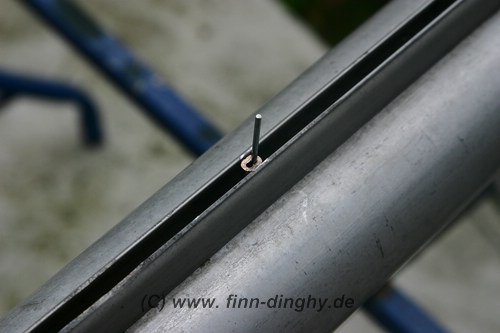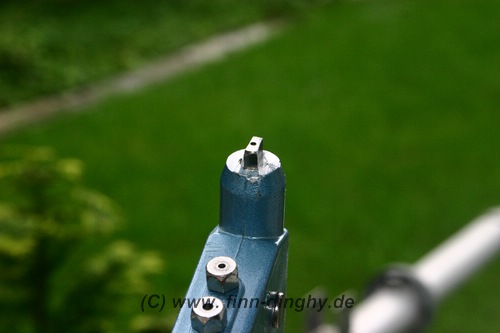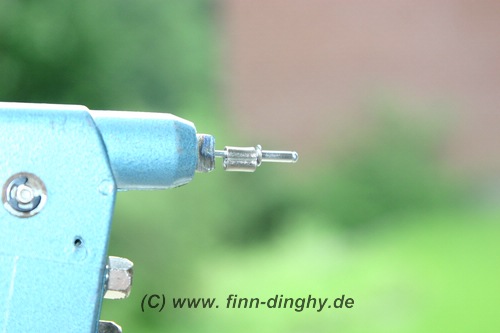Needlespar ALU-Masten
Posted: 2. November 2005 16:58
Aluminium masts
Many were dreaming of metal masts in order to eliminate all the variables and problems of wood. They never imagined the metal mast would make so many problems of its own.
In 1967 the Class asked the IYRU for permission to experiment with glass and aluminium spars. In 1968 several spars of aluminium or glass were produced and tested and the IYRU approved the use of these materials for racing. In 1969 Jack Knights brought an aluminium mast to use at the Gold Cup in Bermuda. Competition between builders was really good in the beginning. Boyce, Bruder and Z-Spars all built one-piece aluminium masts with early success. Stromeyer, a Swede in Austria, built a stainless steel mast. Needlespar built a mast with different size tubes glued together over sleeves. By 1972 about one-third of the Finn sailors were using aluminium masts. Bruder won the Gold Cup in 1972 with one. Bruder's winning the Gold Cup using his own aluminium mast convinced many of the top helmsmen that aluminium masts were better.
Many early aluminium masts broke at the deck or the gooseneck and had to have wooden poles or metal tubes inside the lower section to keep them from getting permanent bends at the gooseneck or from breaking.
1972 Olympics
At this time, the host country for the Olympics supplied both the hulls and the rigs for the Olympics. Many were surprised when the IYRU directed the Germans to provide aluminium masts for the Finn class, as many sailors had never used aluminium masts. Needlespar (England) won the order for 100 of their
2B masts for the Kiel Olympics
after David Hunt promised that all masts would be perfectly identical. The supplied rigs at previous Olympics had never been really identical. This order helped kill off the other aluminium builders.
Needlespar
The 3B came in 1973 as a development of the 2B with constant wall thickness and a wide elliptical base.
The 3M came in 1974 at the Finn Gold Cup with a smaller lower section of variable wall thickness, a three-piece top and took over.
In 1975 Needlespar produced a delta-shaped lower section and single-piece top that was very good in light air but too soft at the deck for heavy air.
In 1975 Needlespar also produced the 4B that incorporated a two- piece top over a wide elliptical base but it never was as good an all-round mast as the 3M.
Since 1974 the 3M has been the most successful aluminium mast with many different tips. Every time Needlespar's designer David Hunt needed a new car, he came with a new tip design for the 3M with a different colour tip. The sailors would buy a new spar, hoping to find a superior coupling of mast top to upper sail leech. At latest count there are black, blue, silver, gold, red, green and purple coloured tips located in Finn fleets around the world. However, the development of the aluminium mast ended up eliminating many light small guys, who were 1/3 of the fleet, because the aluminium masts never developed the tip release of the wooden mast.
Quelle: http://www.finngoldcup2005.ru/eng/hisfinn40_1.html
Many were dreaming of metal masts in order to eliminate all the variables and problems of wood. They never imagined the metal mast would make so many problems of its own.
In 1967 the Class asked the IYRU for permission to experiment with glass and aluminium spars. In 1968 several spars of aluminium or glass were produced and tested and the IYRU approved the use of these materials for racing. In 1969 Jack Knights brought an aluminium mast to use at the Gold Cup in Bermuda. Competition between builders was really good in the beginning. Boyce, Bruder and Z-Spars all built one-piece aluminium masts with early success. Stromeyer, a Swede in Austria, built a stainless steel mast. Needlespar built a mast with different size tubes glued together over sleeves. By 1972 about one-third of the Finn sailors were using aluminium masts. Bruder won the Gold Cup in 1972 with one. Bruder's winning the Gold Cup using his own aluminium mast convinced many of the top helmsmen that aluminium masts were better.
Many early aluminium masts broke at the deck or the gooseneck and had to have wooden poles or metal tubes inside the lower section to keep them from getting permanent bends at the gooseneck or from breaking.
1972 Olympics
At this time, the host country for the Olympics supplied both the hulls and the rigs for the Olympics. Many were surprised when the IYRU directed the Germans to provide aluminium masts for the Finn class, as many sailors had never used aluminium masts. Needlespar (England) won the order for 100 of their
2B masts for the Kiel Olympics
after David Hunt promised that all masts would be perfectly identical. The supplied rigs at previous Olympics had never been really identical. This order helped kill off the other aluminium builders.
Needlespar
The 3B came in 1973 as a development of the 2B with constant wall thickness and a wide elliptical base.
The 3M came in 1974 at the Finn Gold Cup with a smaller lower section of variable wall thickness, a three-piece top and took over.
In 1975 Needlespar produced a delta-shaped lower section and single-piece top that was very good in light air but too soft at the deck for heavy air.
In 1975 Needlespar also produced the 4B that incorporated a two- piece top over a wide elliptical base but it never was as good an all-round mast as the 3M.
Since 1974 the 3M has been the most successful aluminium mast with many different tips. Every time Needlespar's designer David Hunt needed a new car, he came with a new tip design for the 3M with a different colour tip. The sailors would buy a new spar, hoping to find a superior coupling of mast top to upper sail leech. At latest count there are black, blue, silver, gold, red, green and purple coloured tips located in Finn fleets around the world. However, the development of the aluminium mast ended up eliminating many light small guys, who were 1/3 of the fleet, because the aluminium masts never developed the tip release of the wooden mast.
Quelle: http://www.finngoldcup2005.ru/eng/hisfinn40_1.html


